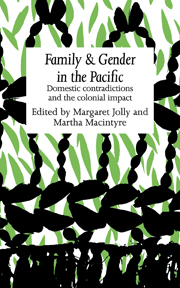Book contents
- Frontmatter
- Contents
- List of contributors
- Acknowledgements
- Map of main island groups of the Pacific
- Map of Papua New Guinea – Provinces
- Introduction
- 1 New England missionary wives, Hawaiian women and ‘The Cult of True Womanhood’
- 2 Changes in the lives of ordinary women in early post-contact Hawaii
- 3 Domestic structures and polyandry in the Marquesas Islands
- 4 The object lesson of a civilised, Christian home
- 5 Medical care and gender in Papua New Guinea
- 6 Suffer the children: Wesleyans in the D'Entrecasteaux
- 7 Women in contemporary Central Enga society, Papua New Guinea
- 8 Better homes and gardens
- 9 God, ghosts and people: Christianity and social organisation among Takuru Wiru
- 10 Sins of a mission: Christian life as Kwaio traditionalist ideology
- 11 Sacred spaces: churches, men's houses and households in South Pentecost, Vanuatu
- 12 Bond-slaves of Satan: Aboriginal women and the missionary dilemma
- Bibliography
- Index
2 - Changes in the lives of ordinary women in early post-contact Hawaii
Published online by Cambridge University Press: 05 November 2011
- Frontmatter
- Contents
- List of contributors
- Acknowledgements
- Map of main island groups of the Pacific
- Map of Papua New Guinea – Provinces
- Introduction
- 1 New England missionary wives, Hawaiian women and ‘The Cult of True Womanhood’
- 2 Changes in the lives of ordinary women in early post-contact Hawaii
- 3 Domestic structures and polyandry in the Marquesas Islands
- 4 The object lesson of a civilised, Christian home
- 5 Medical care and gender in Papua New Guinea
- 6 Suffer the children: Wesleyans in the D'Entrecasteaux
- 7 Women in contemporary Central Enga society, Papua New Guinea
- 8 Better homes and gardens
- 9 God, ghosts and people: Christianity and social organisation among Takuru Wiru
- 10 Sins of a mission: Christian life as Kwaio traditionalist ideology
- 11 Sacred spaces: churches, men's houses and households in South Pentecost, Vanuatu
- 12 Bond-slaves of Satan: Aboriginal women and the missionary dilemma
- Bibliography
- Index
Summary
The lives of women in ancient Hawaiian society and the changes that occurred in them in the early post-contact period have received little attention from anthropologists or historians. Twentieth-century anthropologists presumably considered the task of reconstructing the patterns and significance of late-eighteenth-century Hawaiian women's lives from the disparate fragments of Hawaiian culture extant today impossible, while historians of the archipelago have by and large been content to offer broad-brush, empirical studies of the major external forces influencing Hawaiian history in the last two hundred years. These historians (Bradley 1942; Hobbs 1935; Joesting 1972; Kuykendall 1938, 1953, 1967) have tended to present interpretations of Hawaii's post-contact period of a predominantly Whiggish nature, emphasising progress towards ‘civilisation’ over these decades. The most recent and least complacent general history of Hawaii by Gavan Daws (1974) is deeply concerned about race and racial justice, but its long chronological span and emphasis on external factors influencing Hawaiian history have no made possible any sustained analysis of the changing lives and expectations of Hawaii's original inhabitants, although some interesting interpretations are offered in passing. Marshall Sahlin's recent exposition of Hawaii's early contact period (1981b) traverses the traditional territories of both anthropology and history, and many of his hypotheses have been most useful in my approach, but Sahlins' purpose is more universal in intent than an analysis of any one segment of Hawaiian society.
- Type
- Chapter
- Information
- Family and Gender in the PacificDomestic Contradictions and the Colonial Impact, pp. 45 - 64Publisher: Cambridge University PressPrint publication year: 1989
- 24
- Cited by



